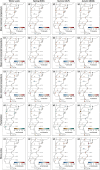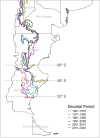Impact of climate change on the spread of fascioliasis into the extreme south of South America
- PMID: 40825058
- PMCID: PMC12377589
- DOI: 10.1371/journal.pntd.0013433
Impact of climate change on the spread of fascioliasis into the extreme south of South America
Abstract
The impact of global warming on the transmission of fascioliasis, a highly pathogenic zoonotic snail-borne disease, was already highlighted during the 2010's. However, since then, only a few studies have tried to relate the climatic change with the uprise of outbreaks in endemic areas of animal or human fascioliasis. This might be because assessing the consequences of a changing climate on the spread of fascioliasis is extremely challenging, as it presents the widest latitudinal, longitudinal and altitudinal distribution known for a snail-borne disease. In the Americas, where it is only caused by Fasciola hepatica, the disease is widespread throughout the continent, except in its southernmost extremity in the Patagonia region, which was believed to be due to the too low temperatures. Though, recent empirical evidence indicates an ongoing spread of the disease into more southern latitudes. The present study aims to assess the long-term evolution of climate change factors and forecast indices throughout this extreme South American region to conclude whether their impact might have been the cause of the southward expansion of the fascioliasis endemic area. The use of seasonal-trend decomposition analyses and of spatial interpolation techniques demonstrated a remarkable climatic change in the Patagonia region allowing to clarify the southern spread of the disease. This is the first study highlighting a clear link between the consequences of a changing climate and the spread of a fascioliasis endemic area and its transmission risk to extreme latitudes. Moreover, it provides some crucial recommendations and concerns regarding the application and interpretation of two widely applied climatic forecast indices. If current climate trends persist, this geographical expansion is expected to progress further. These findings not only provide critical insight into local disease dynamics but also underscore the broader implications of climate-driven changes in the distribution of snail-borne diseases globally.
Copyright: © 2025 Cuervo et al. This is an open access article distributed under the terms of the Creative Commons Attribution License, which permits unrestricted use, distribution, and reproduction in any medium, provided the original author and source are credited.
Conflict of interest statement
The authors have declared that no competing interests exist.
Figures









Similar articles
-
Prescription of Controlled Substances: Benefits and Risks.2025 Jul 6. In: StatPearls [Internet]. Treasure Island (FL): StatPearls Publishing; 2025 Jan–. 2025 Jul 6. In: StatPearls [Internet]. Treasure Island (FL): StatPearls Publishing; 2025 Jan–. PMID: 30726003 Free Books & Documents.
-
[Volume and health outcomes: evidence from systematic reviews and from evaluation of Italian hospital data].Epidemiol Prev. 2013 Mar-Jun;37(2-3 Suppl 2):1-100. Epidemiol Prev. 2013. PMID: 23851286 Italian.
-
Emerging Human Fascioliasis in India: Review of Case Reports, Climate Change Impact, and Geo-Historical Correlation Defining Areas and Seasons of High Infection Risk.Trop Med Infect Dis. 2025 May 2;10(5):123. doi: 10.3390/tropicalmed10050123. Trop Med Infect Dis. 2025. PMID: 40423353 Free PMC article.
-
Ecological niche and distribution patterns of snails that host Fasciola hepatica across South America: Unveiling the hidden landscapes.Vet Parasitol. 2025 Aug;338:110541. doi: 10.1016/j.vetpar.2025.110541. Epub 2025 Jul 9. Vet Parasitol. 2025. PMID: 40645098
-
Home treatment for mental health problems: a systematic review.Health Technol Assess. 2001;5(15):1-139. doi: 10.3310/hta5150. Health Technol Assess. 2001. PMID: 11532236
References
-
- Mas-Coma S, Valero MA, Bargues MD. Fascioliasis. In: Toledo R, Fried B, editors. Digenetic trematodes. 3rd ed. Cham: Springer International Publishing; 2024. pp. 157–201. doi: 10.1007/978-3-031-60121-7 - DOI
MeSH terms
LinkOut - more resources
Full Text Sources
Medical
Research Materials

